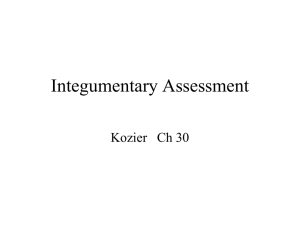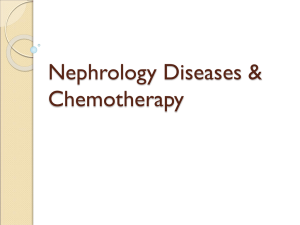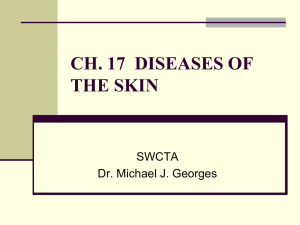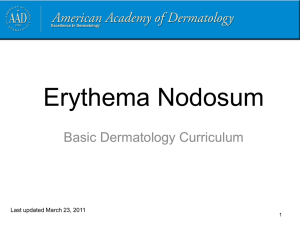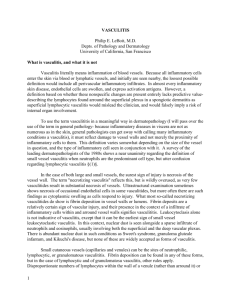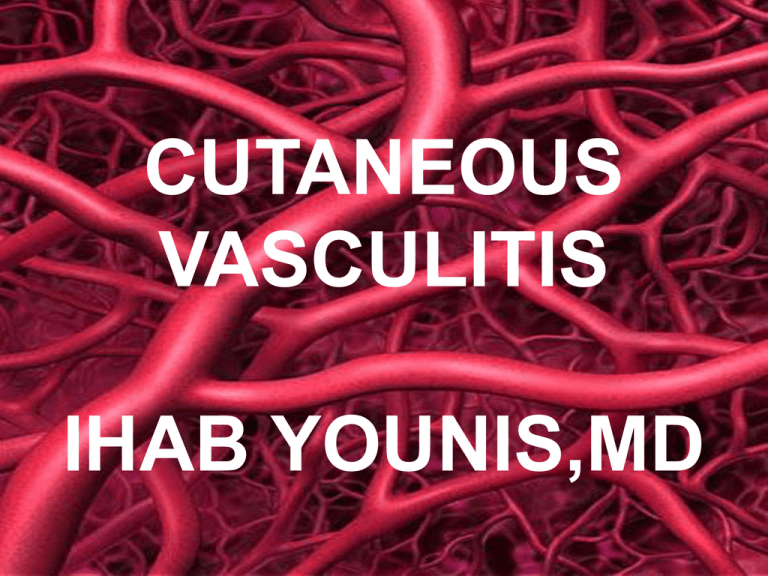
CUTANEOUS
VASCULITIS
IHAB YOUNIS,MD
Classification
I- Small Vessel vasculitis
1- Cutaneous vasculitis
2- Henoch-Schoelein purpura
3- Urticarial vasculitis
4- Erythema elevatum diutinum
5-Granuloma faciale
6-Erythema induratum(Nodular vasculitis)
II- Large vessel vasculitis
Polyarteritis nodosa
III- Neutrophilic vascular reactions:
1- Sweet’s syndrome
2 - Behcet’s disease
3 - Erythema nodosum
4- Pyoderma gangrenosum
IV- Overlap:
Pityriasis lichenoides chronica
I- Small vessel
vasculitis
1-Allergic vasculitis
Etiology
• The exact mechanisms remain unknown
• Although immune complexes are involved
in the pathogenesis, other autoantibodies
such as antineutrophil cytoplasmic antibody,
other inflammatory mediators and local
factors that involve the endothelial cells
and adhesion molecules play an important
role
1- Between one third and one half of the
cases of cutaneous vasculitis are
idiopathic
2-Drugs: almost all drugs are potential
causes . However, The most common
drugs are antibiotics, particularly betalactam drugs, nonsteroidal antiinflammatory drugs, diuretics and foreign
proteins such as streptokinase and those
found in vaccines
3-Various infections may be associated:
– Upper respiratory tract infections and
viral hepatitis are implicated most often
3-Foods or food additives may cause
vasculitis.
4-Collagen vascular diseases ( rheumatoid
arthritis, Sjögren syndrome & SLE in
particular) account for 10-15% of vasculitis
cases
5- Malignancy accounts for less than 1%
of cases of cutaneous vasculitis
Diagram of histopathology
Extravasation of
Perivascular infiltration of
erythrocytes
polymos with formation
of nuclear dust
(leukocytoclasis)
Fibrinoid necrosis of
vessel walls
Clinically
• Palpable purpura is the most frequent:
– Lesions usually are round and 1-3 mm.
– They may coalesce to form plaques, and in
some instances, they may ulcerate
– Observed most often on the legs, but any
surface can be involved
• Ecchymosis may be seen
• Vesicles &hemorrhagic bullae and in
severe cases necrotic areas & ulceration
occur
• Patients may also experience systemic
symptoms with fever, joint , pains and
stomach upsets at any time during an
attack
• The acute rash usually subsides within 23 weeks but may recur
Acute
form
Palpable purpura
Subacute
form
Associations
•
•
•
•
•
Renal
Joint
Gastrointestinal
CNS
Pulmonary
Investigations
• It serves 2 purposes: The first is
determining the presence of systemic
disease. The second is identifying an
associated disorder, which aids in the
prediction of the patient's prognosis.
• Although no routine has been established,
testing for all adult patients includes
complete blood cell count, erythrocyte
sedimentation rate, urinalysis and blood
chemistry panel
• Serologic studies, such as antinuclear
antibody, ANCA, and rheumatoid factor,
should be obtained in patients without an
obvious cause of their disease
• In patients suggested to have lupus
erythematosus or patients who have
urticarial vasculitis, complement levels
may be obtained
• In patients without otherwise identified
disease, tests for paraproteins should
include serum protein electrophoresis,
cryoglobulins, and hepatitis C antibody
• Chest radiograph is part of the routine
evaluation
Treatment
• Elevation of the legs or compression stockings
may be useful
• Patients with an identifiable cause should
receive treatment for that cause e.g. removal of
a drug thought to be causing the vasculitis may
result in rapid clearing of the process in as short
as 2 weeks
• Patients with urticarial lesions may be treated
with antihistamines, sometimes, a combination
of these agents is needed to control the disease
• Some patients respond to nonsteroidal antiinflammatory agents
• Anti-inflammatory agents :
1- Colchicine (Colmetidine) 0.5-0.6 mg PO
bid/tid Has effects against neutrophils
-Adverse effects:
Pregnancy category D , risk of renal
failure, hepatic failure, permanent hair
loss, bone marrow suppression,
numbness or tingling in hands and feet,
disseminated intravascular coagulopathy
and decreased sperm count may occur;
dose-dependent GI upset is common
2-Dapsone: 150-200 PO qd(once/day)
Precautions
-Perform weekly blood counts (first mo),
then perform WBC counts monthly (6
mo), then semiannually; discontinue if
significant reduction in platelets, WBC,
or RBC counts is seen
- Caution in G-6-PD deficiency (patients
receiving >200 mg/d)
• In severe cases or if visceral involvement is
found, patients may require high doses of
corticosteroids (1-2 mg/kg/d)
• In refractory cases, an immunosuppressive
agent (eg,cyclophosphamide 1-2
mg/Kg/day, azathioprine 1-3 mg/Kg/d,
methotrexate 10-25 mg/ week)
2-Henoch-Schonlein
Purpura
• It was first described by Schönlein in 1837
and the manifestations of abdominal pain
and nephritis were reported by Henoch in
1874
• The peak prevalence of HSP is in children
aged 3-10 years
• In the Northern Hemisphere, the disease
occurs mostly from November to January
Etiology
• The etiology of HSP remains unknown
• However, IgA clearly plays a critical role in the
immunopathogenesis of HSP, as evidenced by
increased serum IgA , IgA-containing circulating
immune complexes and IgA deposition in vessel
walls resulting in elaboration of inflammatory
mediators, including vascular prostaglandins
such as prostacyclin
• An antigen may stimulates the production
of IgA. Allergens may include:
- Foods -Insect bites - Cold exposure
- Drugs (eg, ampicillin, erythromycin,
penicillin)
- Infections (eg ,Haemophilus,Mycoplasma,
Shigella, Salmonell, adenoviruses,
Epstein-Barr virus,parvoviruses,varicella)
-Vaccines such as cholera, measles
Clinically
• HSP begins with a symmetrical
erythematous macular rash on the lower
extremities that quickly evolves into
palpable purpura
• The rash can initially be confined to
malleolar skin, but it usually extends to the
dorsal surface of the legs, the buttocks,
and the ulnar side of the arms
• Within 12-24 hours,
the macules evolve
into palpable purpuric
lesions that are dusky
red and have a
diameter of 0.5-2 cm
• The lesions may
coalesce into larger
plaques that resemble
ecchymoses
• GI manifestations occur in about 50% of
cases and usually consist of colicky
abdominal pain, melena, or bloody
diarrhea. Hematemesis occurs less
frequently
• Arthralgia occurs in 60-84% of cases,
commonly affecting the knees and ankles
• The most serious complication of HSP is
renal involvement. It occurs in 50% of
older children but is only serious in
approximately 10% of patients
• Heart: Vasculitis involving the myocardia
can occu.
• Lungs: Vasculitis involving the lungs can
occur, resulting in pulmonary hemorrhage
Investigations
• No specific diagnostic laboratory markers exist
• The plasma coagulation factor XIII is reduced in
about 50% of patients
• Urinalysis reveals hematuria. Proteinuria may
also be found
• CBC can show leukocytosis with eosinophilia
and a left shift. Thrombocytosis is present in
67% of cases
• Serum IgA levels are increased in about 50% of
patients during the acute phase of illness
• The antistreptolysin O (ASO) titer is elevated in
30% of cases
Imaging Studies :
• Abdominal ultrasonography can be used if
GI symptoms are present
• Chest radiography may help to determine
the presence and extent of pulmonary
hemorrhage
• To date, no form of therapy has been shown to
appreciably shorten the duration of HSP; thus,
treatment for most patients remains primarily
supportive
• Corticosteroids may be considered for the
following serious situations :
- Persistent nephrotic syndrome
Crescents in more than 50% of glomeruli
-Severe abdominal pain
-Substantial GI hemorrhage
-Severe soft tissue edema
-Severe scrotal edema
-Neurologic system involvement
-Intrapulmonary hemorrhage
•
•
•
•
The following protocol is suggested :
Induction with 250-750 mg of IV
methylprednisolone every day for 3-7 days plus
cyclophosphamide 100-200 mg/d PO
Maintenance with prednisone 100-200 mg PO
every other day, plus cyclophosphamide 100200 mg/d PO 30-75 days
Taper prednisone by approximately 25 mg/mo,
while the cyclophosphamide dose remains
constant
Discontinue treatment after at least 6 mo by
abruptly discontinuing cyclophosphamide and
complete prednisone taper
3-Urticarial vasculitis
Etiology
• It is strongly associated with connective
tissue diseases e.g. it is present in 20 % of
patients with SLE
• Other associations include: physical
urticarias, hepatitis, cance colon or drugs
as AC inhibitors, fluoxetine, thiazides
• Immune complexes(circulating and
deposited in vessel walls) can be found in
75% of cases
Clinically
• Erythematous, indurated weals with
purpuric foci
• Weals tend to be of longer duration, often
longer than 24 hours and tend to resolve
with some residual pigmentation or
ecchymosis. Patients experience more
burning rather than itching
• Angioedema,livedoreticularis, nodules and
bullae may be found
• Constitutional symptoms, GIT &
respiratory symptoms, lymphadeopathy,
glomerulonephritis & occular affection may
be present
Urticarial
vasculitis
Investigations
• ESR is elevated
• Look for hypocomplementemia
• Look for changes of associated signs
Treatment
• Corticosteroids : 0.5-1.5 mg/kg/d PO initial; taper
as disease responds; if chronic use required,
qod administration is safer
• Other drugs that are effective include:
- Dapsone 100-200 mg once daily
- Colchicine 0.6mg twice daiy
- Hydroxychloroquine (Alexoquine 250 mg)
200 mg once or twice daily
• Oral antihistamines for angioedema
4- Erythema
Elevatum
Diutinum
Etiology
• First described in 1888 by Hutchinson and
in 1889 by Bury
• The pathophysiology of EED is not well
understood
• Direct immunofluorescence shows
deposits of complement as well as IgG,
IgM, IgA and fibrin around the damaged
vessels
• Initiation of EED may occur via activation
of cytokines such as interleukin 8, which
causes selective recruitment of leukocytes
to tissue sites
Clinically
• Patients usually present with persistent, firm
lesions on the extensor surfaces of their skin,
especially over the joints
• These lesions are most often nodules and round
or oval plaques
• The color of the lesions progresses over time
from yellow or pinkish to red, purple, or brown
• Lesions increase in number and size over time.
They may also enlarge during the day and return
to their previous size overnight
• The lesions can be completely
asymptomatic, painful, or cause a
sensation of burning or itching. These
symptoms can be exacerbated by cold
• The lesions
usually feel firm
and are freely
movable over
the underlying
tissue
Investigations
• The erythrocyte sedimentation rate in
patients with EED is often elevated
• Direct immunofluorescence study results
show including deposits of complement,
immunoglobulins (IgG, IgA, IgM) and fibrin
intravascularly and perivascularly
Treatment
• Dapsone 50-300 mg/d PO revolutionized
the treatment of patients with EED
• Systemic steroids generally have not been
found to be effective
• Surgical excision of the lesions is
sometimes performed to provide
symptomatic relief
5-Granuloma Faciale
Etiology
• Lever and Leeper first recognized GF as
a distinct entity in 1950
• Sun exposure may play a role
• Some cases are idiopathic
• A gamma interferon-mediated process
has been suggested
Clinically
• Lesiona are usually asymptomatic
• Solitary or, more commonly, multiple, soft,
elevated, and well-circumscribed papules,
plaques, or nodules. They have a smooth
surface with prominent follicular orifices
(peau d'orange)
• Most commonly located over the face
• The size varies from a few millimeters to
several centimeters in diameter
• The color varies from shades of dull red to
brown, blue, and purple. Lesions may
darken upon sun exposure
Histopathology
•Normal epidermis
•Grenz zone
•Polymorphs and a few
other inflammatory
cells are present
•Fibrin replacement of
the vessel wall as well
as perivascular fibrin
deposition
Prominent
perivascular
fibrous lamellae
Infiltrate contains
eosinophils,
leukocytes, plasma
cells, lymphocytes,
and a few
histiocytes
Treatment
•
•
•
•
•
Surgical excision
Dermabrasion
Argon laser(Argon,CO2,Pulsed dye )
Electrosurgery
Cryotherapy
•
•
•
•
•
GF is notoriously resistant to treatment;
therefore, many different medical therapies
have been tried
Topical & intralesional corticosteroid
injections
Intralesional gold injections
PUVA
Radiotherapy
Dapsone 25-200 mg/d PO
6-Erythema Induratum
(Nodular Vasculitis)
• In 1861, Bazin gave the name erythema
induratum to a nodular eruption that occurred on
the lower legs of young women with tuberculosis
• In 1945, Montgomery et al, coined the term
nodular vasculitis to describe nodules of the legs
that showed histopathologic changes similar to
those of erythema induratum
• Therefore, erythema induratum/nodular
vasculitis complex is classified into 2 variants.
Erythema induratum of Bazin type(related with
TB) and nodular vasculitis or erythema
induratum of Whitfield type. Bazin type is related
with tuberculous origin, but Whitfield type is not
Etiology
• M tuberculosis is the cause of erythema
induratum. Recently, hepatitis C virus has
been suggested, but a direct relationship
remains unclear
• The cause is unknown in cases of nodular
vasculitis with a negative tuberculin skin
test reaction
Clinically
• A past or present history of TB at an
extracutaneous site(mostly pulmonary)
occurs in about 50% of patients
• Crops of small, tender, erythematous
nodules may be observed:
– Commons sites are the calves, although
the shins are also sometimes involved
– The nodules are concentrated on the
lower third of the legs, especially around
the ankles
– Lesions may ulcerate with
bluish borders, which
may be precipitated by
cold weather
Histopathology
• Septal & lobular granulomatous
inflammation with neutrophilic vasculitis is
characteristic and contrasts with erythema
nodosum (primarily septal)
• Caseation-like necrosis may also be seen.
The histologic features are not specific
Lymphoid
infiltrate in
the wall &
around it
Nodules in the subcutis
Treatment
• Antituberculous therapy(for erythema induratum
of Bazin):
- Isoniazid (Isocid 200 tab) 5-10
mg/kg PO qd or divided bid; not to exceed 300
mg/d. Prophylactic doses of 6-50 mg of
pyridoxine daily are recommended
- Rifampin (Rimactane300 cap) 10 mg/kg/d PO or
450-600 mg PO qd; not to exceed 600 mg qd
- Ethambutol (Etibi 500 tab) 15-25 mg/kg PO qd
- Pyrazinamide (PTB 500 tab) 15-30 mg/kg PO qd;
not to exceed 2 g/d
• Bed rest with systemic steroids
• Potassium iodide is sometimes applied,
with high efficacy; however, this therapy
requires caution when used in children or
in patients with thyroid disease
- Dose:Liquid supersaturated potassium
iodide 3 gtt tid in juice and increase by
1 gtt tid; not to exceed 15 gtt tid
II- Large vessel
vasculitis
Polyarteritis Nodosa
Etiology
• First described by Kussmaul and Maier in 1866
• Approximately 30% patients with PAN are
positive for hepatitis B surface antigen
– In these patients, hepatitis B antigen and circulating
hepatitis B antigen-antibody aggregate in the serum
and in vascular lesions
– This finding suggests that PAN results from
complexes of antibodies and exogenous antigen,
such as hepatitis B antigen
Clinically
• Skin: About 40% of patients manifest
dermatologic symptoms and signs
including rash, purpura, nodules,
cutaneous infarcts, livido reticularis, and
Raynaud’s phenomenon
PAN
• Renal system: About 60% of patients with PAN
have renal involvement. Ischemic changes in the
glomeruli can cause renal failure or hypertension
• Musculoskeletal system: Symptoms manifest as
arthritis, arthralgia, or myalgia
• Central nervous system: Transient symptoms of
cerebral ischemia, including typical spells of
transient monocular blindness, are the most
commonly presenting
Investigations
• No diagnostic serologic tests are available
• Positive Antineutrophil cytoplasmic
antibody (ANCA) titers often are found;
however, they are not diagnostic
• Leukocytosis, with neutrophil
predominance
• ESR is almost always elevated
• Hypergammaglobulinemia is found in 30%
of patients with PAN
• Arteriogram reveals microaneurysms in
the small and medium-sized arteries of the
kidneys and abdominal viscera
• EEG shows generalized slow wave activity
during periods of encephalopathy or toxic
delirium
•Prominent eosinophilic "fibrinoid"
necrosis involving the intima and media
•The lumen has been occluded by
granulation tissue
Treatment
• Treatment may include a regimen of
prednisone (1 mg/kg/d) and
cyclophosphamide (2 mg/kg/d). In general,
patients respond better to combined
therapy with immunosuppressants and
corticosteroids than to steroids alone
• In contrast, for hepatitis B–related PAN,
treatment consists of schemes that include
plasmapheresis and antiviral agents
III- Neutrophilic
vascular reactions
1- Acute Febrile
Neutrophilic
Dermatosis
(Sweet's syndrome)
Etiology
Initially described in 1964 by Robert Sweet
I-Associated with a (malignant) neoplasm
in 20-25% of the cases
– Leukemia
– Lymphoma
– Multiple myeloma
– Genitourinary cancers
II- Multiple infections :
- Streptococcal pneumonia is the most
commonly described infection.Other
bacterial infections include those due to
Salmonella ,Staphylococcus ,enterocolitica,
Entamoeba coli, Helicobacter pylori and TB
- Viral agents such as HIV, cytomegalovirus
(CMV), hepatitis A, and hepatitis B
III - Multiple drugs have been reported to
cause Sweet syndrome:
– Trimethoprim-sulfamethoxazole (Sutrim), alltrans retinoic acid, and minocycline, which have
all appeared in more than 1 case report
IV - Systemic disorders (15 %) :
– The most commonly associated diseases are
Crohn disease, ulcerative colitis, Behçet
disease, lupus erythematosus and rheumatoid
arthritis
Clinically
• Fever typically precedes the appearance
of each crop of lesions by several days to
weeks
• Headache, malaise, and arthralgias are
common
• Episodes of disease cluster in the spring
and autumn
• Skin manifestations
– Typical skin lesions are reddish blue or
violet(plum color) papules, plaques, or
nodules. Lesions may be studded with
pustules. Papules often coalesce into
circinate plaques 2-10 cm in diameter
– Plaques can cause pain and burning, but they
are not pruritic
– Ulcers and bullae are more common in
malignancy-associated disease
• The face, neck, and extremities primarily
are affected, characteristically in an
asymmetric distribution. Lesions on the
dorsum of the hand are not uncommon
• Lesions spontaneously resolve without
scarring, or they resolve after treatment
• Sweet syndrome is known to cause
pathergy (Köbner phenomenon), in which
lesions occur at sites of minor trauma
• Mucosal lesions
– Oral lesions can occur on the lips, buccal
mucosa, and/or tongue. These lesions most
commonly appear as ulcers in Sweet
syndrome patients with hematologic disorders
– Conjunctivitis and episcleritis may also occur
• Extracutaneous manifestations
– Pulmonary manifestations are the most
common and may manifest as a chronic
cough or pulmonary infiltrates on chest
radiographs
– Other extracutaneous sites that have been
reported include the bones, intestines, joints,
pancreas, liver, heart, muscles, spleen, and
kidneys
– Proteinuria, hematuria, and decreased
creatinine clearance have been reported
Diagnostic criteria
The presence of 2 major and 2 minor
clinical findings:
- Major criteria
• Abrupt onset of tender or painful
erythematous plaques or nodules
• Predominantly neutrophilic infiltration
in the dermis without leukocytoclastic
vasculitis
- Minor
criteria
• Preceding nonspecific respiratory or
gastrointestinal tract infection or
vaccination or associated with inflammatory
disease, hemoproliferative disorders, solid
malignant tumors, or pregnancy
• Periods of general malaise and fever (fever
>38°C)
• Laboratory values during onset showing
ESR >20 mm, positive C-reactive protein
result, segmented nuclear neutrophils,
bands >70% in peripheral blood smears,
and leukocytosis (count >8000/mL)
(meeting 3 of 4 of these values is
necessary(
Investigations
1- A CBC count with differential must be ordered
to screen for underlying hematologic disorders:
– Neutrophilia is typically present, but the
absence of neutrophilia in a patient who is
neutropenic does not rule out Sweet syndrome
– Anemia and thrombocytopenia are common in
patients with underlying malignancy
2-ESR is elevated in more than 90% of cases.
This is, of course, a nonspecific manifestation of
inflammation
3-Urinalysis may show proteinuria
4-If an underlying malignancy is
suspected, the appropriate imaging
modality should be used for early
detection and treatment
Treatment
• In most cases, prednisone is extremely
and rapidly effective, in doses of 40-80 mg
qd(once daily) or divided bid/qid(4 times
daily); taper slowly over 4-6 wk; qod(every
other day) tapering may decrease adverse
reactions
• For long-term management, numerous drugs
may be helpful. They work by inhibiting
neutrophil chemotaxis, but none have been
shown to be better than corticosteroids
– Indomethacin, colchicine and potassium
iodide were helpful in small series of patients
– Dapsone, cyclosporine, etretinate,
pentoxifylline, and clofazimine also have been
used, with anecdotal success
– Doxycycline, metronidazole, isotretinoin,
methotrexate, cyclophosphamide, pulse
doses of methylprednisolone& interferon
alpha are also reportedly successful
– However, despite the initial excellent
response, recurrences are common and
generally develop as steroid use is being
tapered. If the underlying disease flares, it
may take longer to effectively taper therapy
– High-potency topical steroids (eg, clobetasol
propionate 0.05%) or intralesional
glucocorticoids (eg, triamcinolone acetonide
3.0-10 mg/mL) may also be useful in localized
lesions
2- Behçet Disease
• Named in 1937 after the Turkish dermatologist Hulusi Behçet who
suggested the HSV as a
causative agent in his first report
• Most prevalent (and more virulent) in the
Mediterranean region, Middle East,and Far
East, with an estimated prevalence of
1 case per 10,000 persons
• In Turkey, the male-to-female ratio was 16:1
among 427 patients
Etiology
• Immunogenetics
– HLA-B51 or its B101 allele is significantly
associated with BD
– The MICA allele which is thought to be in
linkage with HLA-B51 has recently been
shown to be significantly associated with BD
(74%), compared with controls (45.6%) in
Japan
• Viral and bacterial infection
- Herpes simplex virus DNA has been
detected in saliva, genital ulcers, and
intestinal ulcers
- Hypersensitivity to streptococcal
antigens plays an important role
• Immunological abnormalities :
- The Th1 cytokine interferon (IFN) level
is elevated in serum, in skin T cells,
and cerebrospinal fluid
- The Th2 cytokine IL-6 is also increased
in the serum of patients with BD
- Levels of TNF–alpha, TNF receptor 1,
IL-1, IL-8, IL-10 and IL-13 are elevated
• Endothelial and vascular dysfunctions:
- Antiendothelial cell antibodies show
significantly increased prevalence in BD
- T cells (mostly CD4 cells), B cells, and
neutrophils are infiltrated perivascularly
- The level of endothelin 1 & 2 is
increased in BD vascular involvement
- Endothelial cell–dependent vasodilator
function is significantly impaired
Clinically
• Oral ulcers (70 %)
– Indistinguishable from common aphthae
– Aphthae may be more extensive, more
painful, more frequent, and evolve quickly
from a pinpoint flat ulcer to a large sore
– Lesions can be shallow or deep (2-30 mm in
diameter) and usually have a central,
yellowish, necrotic base and a punched-out,
clean margin
– They can appear singly or in crops, are
located anywhere in the oral cavity
– They persist for 1-2 weeks, and subside
without leaving scars
– The interval between recurrences
ranges from weeks to months
• Genital manifestations
– Genital ulcers resemble their oral
counterparts but may cause greater scarring.
They have been found in 56.7-97% of cases,
but their appearance is mostly a secondary
symptom that accompanies oral ulcers
– In males, the ulcers usually occur on the
scrotum, penis, and groin .In females, they
occur on the vulva, vagina, groin, and cervix
– Ulcers have also been found in the urethral
orifice and perianal area
– Orchiepididymitis is observed in 10.8% of
men
• Cutaneous manifestations (58.6-97%)
–Erythema nodosum–like lesions, which are
most common
– Pseudofolliculitis
–Erythema multiforme–like lesions
–Acne-like lesions
–Ulcers
–Lesions resembling Sweet syndrome
–Bullous necrotizing vasculitis
–Pyoderma gangrenosum
–Pathergy
Pathergy- An erythematous papule larger than 2 mm
at the prick site 48 hours after the application of a 20to 22-gauge sterile needle, which obliquely penetrated
avascular skin to a depth of 5 mm as read by a
physician at 48 hours
• Ocular manifestations
- Uveitis
- Hypopyon and its
(ant&post)
sequelae
- Cataracts
- Glaucoma
- Synechiae
- Retinal vasculitis
- Hemorrhag
- Retinal detachment
• Neurologic manifestations (5-10%):usually
occur later in the course of disease
- Meningoencephalitis
- Spastic paralysis and incontinence
- Personality changes
- Cranial nerve abnormalities:difficulty in
swallowing and deafness
• Vasculopathy
- Deep venous thrombophlebitis has been
described in about 10% of patients
- Noninflammatory vascular lesions
include arterial and venous occlusions,
varices, and aneurysms
• Arthritis and arthralgias occur in any
pattern in as many as 60% of patients
• Gastrointestinal manifestations
• Renal manifestations(Glomerulonephritis
and epididymitis) occur in about 10% of
the patients
• International criteria for the classification of BD
(1990) are as follows:
– Recurrent oral ulceration at least 3 times/year
+ 2 of the following :
• Recurrent genital ulceration
• Eye lesions - (1) Uveitisor (2) retinal
vasculitis
• Skin lesions - (1) Erythema nodosum–like
lesions, pseudo-folliculitis, and
papulopustular lesions or (2) acneiform
nodules in postadolescent patients not
receiving corticosteroids
• Positive pathergy test
Investigations
– C-reactive protein, ESR, leukocyte count, and
complement components and acute-phase
reactants all may be elevated during an acute
attack
– Elevations occasionally are found in IgA and
immunoglobulin M (IgM) levels and immune
complexes
– None of these findings is specific for the
diagnosis of Behçet disease, but they can
corroborate active disease
Histopathology
Mononuclear &neutrophilic
infiltrate with RBCs
extravasation without fibrin
deposition
Treatment
• Prednisone (Hostacorten)60 mg PO /d
• Immunomodulators:
- Colchicine 0.6 mg PO bid or tid
- Dapsone 50-100 mg/d PO
- Levamisole 150 mg PO twice a wk
- Cyclosporine (Sandimmune, Neoral)
2.5-5 PO mg/kg/d in bid
- Tacrolimus(Prograf) 0.15 mg/kg/d PO
- Thalidomide (Thalomid) 100-300 mg/d PO
• Immunosuppressives
- Azathioprine (Imuran) 1-2 mg/kg/d (50200 mg) PO
- Cyclophosphamide (Cytoxan) 1-2
mg/kg/d PO
3- Erythema Nodosum
Etiology
– Bacterial Infections:
• Tuberculosis
• Yersinia enterocolitica: A gram-negative
bacillus causes diarrhea and abdominal pain
• Mycoplasma pneumoniae
• Leprosy
• Lymphogranuloma venereum
• Campylobacter
-Fungal infections :
• Coccidioidomycosis
• Histoplasmosis
• Blastomycosis
-Drugs: Sulfonamides and halide agents
• Gold and sulfonylureas
• Oral contraceptive pills are implicated in
an increasing number of report
-Enteropathies: Ulcerative colitis and Crohn
disease may trigger EN
-Hodgkin disease and lymphoma EN
associated with non-Hodgkin lymphoma
may precede the diagnosis of lymphoma
by months
-Sarcoidosis: The most common cutaneous
manifestation of sarcoidosis is EN.
Lofgren syndrome involves: EN, hilar
lymphadenopathy, fever, arthritis, and
uveitis. This presentation has a good
prognosis with complete resolution within
several months in most patients
-Behçet disease is associated with EN
-Pregnancy: Some patients develop EN
during pregnancy, most frequently during
the second trimester
Clinically
• The eruptive phase of EN begins with flulike
symptoms of fever and generalized aching and
arthralgia occurs (in 50% of cases) and may
precede or appear after the eruption
• Primary skin lesions: begin
as red tender nodules.
Lesion borders are poorly
defined and vary from 2-6 cm
• During the first week, lesions
become tense, hard, and painful
• Distribution of skin lesions: lesions appear
on the anterior leg; however, they may
appear on any surface
• Color of skin lesions: Lesions change color
in the second week from bright red to
bluish or livid. As absorption progresses,
the color gradually fades to a yellowish
hue, resembling a bruise. This disappears
in 1 or 2 weeks as the overlying skin
desquamates
• Hilar lymph nodes: Hilar adenopathy may
develop as part of the hypersensitivity
reaction of EN. Bilateral hilar
lymphadenopathy is associated with
sarcoidosis, while unilateral changes may
occur with infections and malignancy
• Most lesions in infection-induced EN heal
within 7 weeks, but active disease may
last up to 18 weeks. In contrast, 30% of
idiopathic EN cases may last more than 6
months
Investigations
• Throat culture to exclude strept infection
• ESR It is often very high
• Antistreptolysin titer is elevated in some
patients with streptococcal disease, but
normal values do not exclude infection
• Stool examination, since along with the
appropriate history of gastrointestinal
complaints, a stool examination can
exclude infection by Yersinia, Salmonella,
and Campylobacter organisms
• Chest radiographs to exclude sarcoidosis
and tuberculosis and to document hilar
adenopathy
• Intradermal skin tests can be used to
exclude tuberculosis and
coccidioidomycosis
Histopathology
• Punch biopsies usually are not adequate.
Deep skin incisional biopsies are required
as findings are localized to the
subcutaneous
tissue
Treatment
• Supersaturated potassium iodide liquid :
3 gtt tid in juice, increase by 1 gtt tid; not to
exceed 15 gtt tid
• Mechanism of action in EN is unknown,
but it is known to enhance response by
potentiating neutrophil activity
• Prolonged use may result in
hypothyroidism
• Relief may occur within 24 h. Most lesions
completely subside within 10-14 d
• Potassium iodide is not effective for all
patients with EN. Patients who receive
medication shortly after the initial onset of
EN respond more satisfactorily than
patients with chronic EN
• Anti-inflammatory agents : Provide symptomatic
relief for lesional tenderness, arthralgia & fever
- Aspirin (325-650 mg PO q4-6h )
- Indomethacin (Indocid25-50 mg PO bid/tid
- Colchicine : 0.5-1.2 mg PO initially, followed by
0.5-0.6 q1-2h or 1-1.2 mg q2h until response is
satisfactory. Reduces formation of uric acid
crystals in affected joint, thereby reducing
amount of acute inflammation and pain; also
decreases uric acid levels in blood
4-Pyoderma
Gangrenosum
Etiology
• No specific causes of PG have been
identified, but trauma to the skin
(pathergy) may induce new lesions
• Altered neutrophil chemotaxis, is believed
to be involved
Clinically
• Patients with PG usually describe the initial
lesion as a spider bite reaction, with a small, red
papule or pustule changing into a larger
ulcerative lesion, but they have no evidence that
a spider actually caused the initial event
• Pain is the predominant historical complaint
• Arthralgias and malaise may often be present
Two main variants of PG exist:
– Classic PG is characterized by a deep
ulceration with a violaceous border that
overhangs the ulcer bed. These lesions of PG
most commonly occur on the legs, but they
may occur anywhere on the body
– Atypical PG has a vesiculopustular "juicy"
component. This is usually only at the border,
is erosive or superficially ulcerated, and most
often occurs on the dorsal surface of the
hands, the extensor parts of the forearms, or
the face
Classical PG
Early PG treated by IL
Atypical PG
Atypical PG
Commonly associated diseases include:
• Ulcerative colitis or regional
enteritis/Crohn disease
• A polyarthritis that is usually symmetric
and may be either seronegative or
seropositive
• Hematologic diseases such as leukemia
Investigations
• Routine blood work to evaluate for an underlying
systemic illness: CBC; a comprehensive
chemistry profile, including a liver function test;
and a urinalysis
• A hepatitis profile should be performed to rule
out hepatitis
• Serum and/or urine protein electrophoresis, and
bone marrow aspiration should be performed if
indicated to evaluate for hematologic
malignancies
Treatment
• Prednisone (Hostacorten) 0.5-2 mg/kg/d PO
• Immunosuppressives
- Cyclosporine (Sandimmune, Neoral) 3-5
mg/kg/d PO/IV,
- Azathioprine (Imuran) 1-2 mg/kg/d (50200 mg) PO
- Cyclophosphamide (Cytoxan) 1-2
mg/kg/d PO
-Tacrolimus (Prograf): Suppresses humoral
immunity (T-lymphocyte). 0.05 mg/kg/d IV
or 0.15-0.30 mg/kg/d PO divided bid
• Immunomodulators : These agents have
effects on the activity of the immune
system:
- Thalidomide (Thalomid):50-300 mg/d
PO qd
• Clofazimine (Lamprene) : 100mg/d PO
qd mechanism of action is unknown
Prognosis
• The prognosis of PG is generally good; however,
recurrences may occur, and residual scarring is
common
• Many patients with PG improve with initial
immunosuppressive therapy and require minimal
care afterwards; however, many patients follow a
refractory course and multiple therapies fail
• Some patients demonstrate pathergy, and, in
such instances, protection of the skin from
trauma may prevent a recurrence
Pityriasis Lichenoides
Types
1-Pityriasis lichenoides chronica (PLC):
The more common form
2-Pityriasis lichenoides et varioliformis
acuta (PLEVA) or Mucha-Habermann
disease
Etiology
• Most cases of PLEVA cannot be attributed
to any one cause and are idiopathic
• Familial outbreaks, clustering of cases &
comorbid symptoms have been used to
support a hypersensitivity reaction to
infectious agents, although clear causality
is lacking
• The most commonly reported associated
pathogens are Epstein-Barr virus (EBV),
Toxoplasma gondii & human immunodeficiency virus (HIV)
• some authors don not consider PLEVA as a
type of vasculitis but a self-limited
lymphoproliferative disease because:
- Fibrin is not present in the walls of vessels
- Thrombi are not found in the lumen
- CD30 cells, which are associated with
large cell lymphoma, have been identified
in the infiltrate of PLEVA
Clinically
• PLEVA and PLC are not distinct diseases,
but rather, they are different manifestations of the same process, although the
process is accelerated in PLEVA
• PLC presents as small erythematous–to–
reddish brown papules, although with
increased numbers compared to PLEVA. A
fine scale usually is found, although not
initially, which has been likened to frosted
glass. The eruption often is polymorphic,
with lesions at different stages of evolution
• PLEVA presents acutely with 10-50
erythematous–to–reddish brown or purpuric
round or ovoid lichenoid papules that are 5-15
mm in diameter. Many papules demonstrate a
pseudovesicular summit evolving to a central
necrosis and a hemorrhagic crust .
• PLEVA lesions may evolve into lesions of PLC
• Lesions may be distributed symmetrically or
asymmetrically on the trunk, buttocks, and
proximal extremities, with occasional acral
involvement. Lesions may appear on the palms,
soles, face, and scalp. Asymmetric or segmental
nondermatomal presentations have been
reported
• Erosions and hemorrhagic crusts may be found
• Mucosal lesions consisting of irregular erythema
and superficial ulcerations on the buccal mucosa
and palate have been reported
• Most lesions heal with postinflammatory
changes, such as a transient or persistent
leukoderma or hyperpigmentation
PLEVA
Investigations
• Tailor the workup to each patient's
presentation to exclude a possible cause
e.g.
– EBV IgM/IgG viral antigen
– Erythrocyte sedimentation rate
– Hepatitis B & C surface antigen,
antisurface antibody, and anticore IgM
– HIV screening
– Rapid plasma reagin
– Throat cultures
– ELIZA for Toxoplasma
Wedge-shaped perivascular
lymphocytic infilterate
- Parakeratosis
- Lymphocytes at holes inside keratinocytes
High power of the previous picture
Extravasation of RBCs into the
epidermis
Few atypical lymphocytes (AL(
Treatment
• Antibiotics :
- Tetracycline (Hostacyclin) 1-2 g PO
divided bid/qid
- Erythromycin (Erythrocin) 250 mg PO qid
• UV radiation, produce photoproducts
resulting in suppression of both DNA
synthesis and cell division
• Acitretin : 0.75-1 mg/kg/d PO in divided doses;
increase at weekly intervals by 0.25 mg/kg/d up
to 1.5 mg/kg/d; establish maintenance dose (0.50.75 mg/kg/d) after 8-10 wk of therapy
• Methotrexate 0.3 mg/kg/wk; not to exceed 20
mg: inhibits dihydrofolate reductase, thereby
hindering DNA synthesis and cell reproduction






